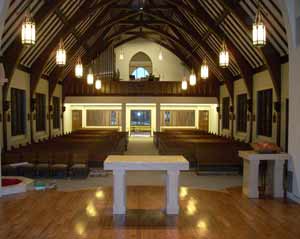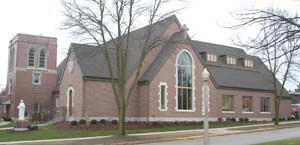 Photos of the interior, top, and exterior, below, of St. John the Evangelist Church in Kohler show the result of the $2.6 million renovation project that enlarged the church, provided handicap accessibility and refurbished the interior while maintaining the original character of the church so that visitors would not be able to detect where the new construction began. (Submitted photos by Bill McGinnis)KOHLER — It wasn’t easy building a church in Kohler in the first place.
Photos of the interior, top, and exterior, below, of St. John the Evangelist Church in Kohler show the result of the $2.6 million renovation project that enlarged the church, provided handicap accessibility and refurbished the interior while maintaining the original character of the church so that visitors would not be able to detect where the new construction began. (Submitted photos by Bill McGinnis)KOHLER — It wasn’t easy building a church in Kohler in the first place.
According to the book “A God-Given Talent,” by Anna Passante, the town’s founder, Walter Kohler, didn’t want any churches in Kohler but relented as the number of Catholics grew.
On Sept. 22, 1940, St. John Evangelist Catholic Church was dedicated at 600 Green Tree Road. Archbishop Samuel Stritch was the archbishop of Milwaukee and Fr. John Carroll was the church’s first pastor
Fr. Robert Lotz is now pastor and on Feb. 7, 2011 the church celebrated another dedication. This time, Archbishop Jerome E. Listecki came to St. John Evangelist to bless and dedicate the church after a massive renovation project enlarged the church, provided handicap accessibility and refurbished the interior.
“They really had wanted this project for many years and it really represents what they really hoped for,” Fr. Lotz told your Catholic Herald, noting that the renovation project made the church more accessible than it had been in the past and created more space for people to gather and celebrate.
The biggest change to the church was the 8,445-square-foot addition that included meeting rooms, a gathering space and narthex. An elevator was installed with access to the choir loft and lower level. The interior of the church was painted, statuary relocated and new pews, reconciliation rooms and baptismal font installed. The altar was also moved and reduced in size and a canopy was installed in front of the church’s exterior to shelter visitors from the elements.
The project addressed one of the church’s pressing needs – its small capacity. Among the features of the narthex are the glass partitions that can be opened to create additional seating. This seating option provides the church with the ability to handle overflow crowds, should the church proper reach its 485-person capacity.
This seating option provides the church with the ability to handle overflow crowds, should the church proper reach its 485-person capacity.
Though the parish community has been in the renovated church for just two months, Fr. Lotz said that they’ve already had to open the glass partitions to accommodate a larger crowd for worship at Christmastime. “We hope to use it at Easter and graduation and those kinds of events,” he said. “The reason why it’s portable space is so that we can use it when we need to, but we don’t have the need for it all the time.”
The narthex is awaiting the installation of several large stained glass windows, which are scheduled to arrive April 11. Currently, the area is enclosed with glass.
The stained glass will be of the same quality as the original windows still in the church. The entire renovation was designed to keep the Gothic design of the existing church and not look like a contemporary add-on.
The architect for the $2.6 million project was TWP Architecture in Elm Grove. The building contractor was Hamann Construction Company of Manitowoc.
The church had the money on hand for the expansion and renovation project, but collected memorials.
The original church, designed by the architectural firm of Brust & Brust, was built in the English Rural Gothic style in order to blend in with the rest of the community, according to Passante’s book. The final cost of the church, which accommodated 400 people, and rectory was $67,748 in 1940.
Maintaining the original character of the church was a major consideration when planning the renovation and expansion. Church planners wanted to keep the architectural integrity of the old church so that visitors would not be able to detect where the new construction begins.
The spacious narthex, which replaces the original space, is probably the most noticeable change. One of the most important improvements is the addition of the elevators, which makes the church handicap accessible so as to meet the needs of everyone in the parish.
